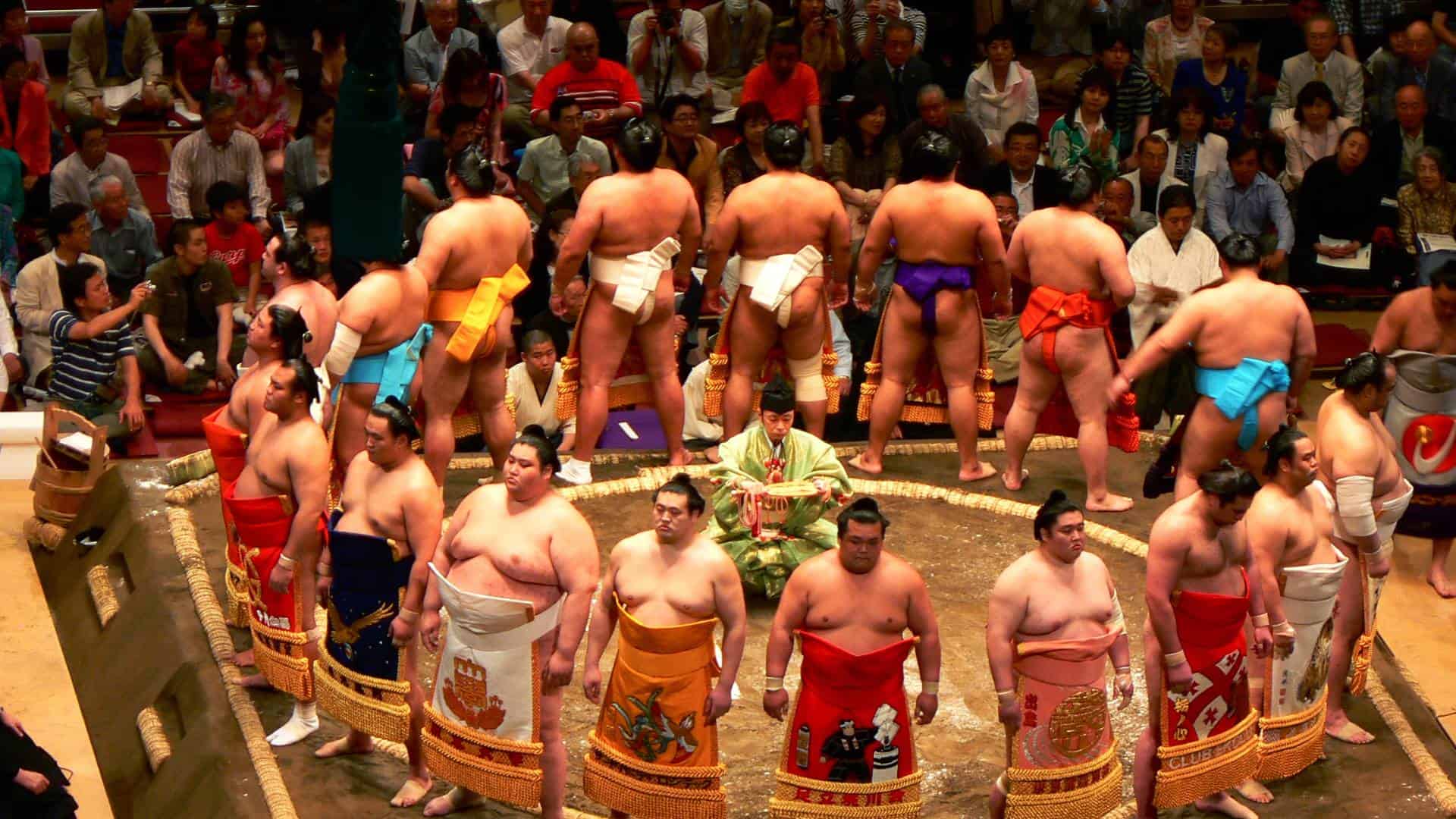Sumo wrestling, a sport deeply embedded in Japanese culture, offers a unique and thrilling experience for travellers. This ancient martial art, with its dramatic clashes and ceremonial rituals, provides a fascinating insight into Japan’s rich cultural heritage.
This guide offers a detailed exploration of sumo, including its historical roots, intricate rules, essential terminology, and the best venues to witness this sport in Japan. Whether you’re a seasoned fan or new to sumo, this guide will help you fully appreciate and enjoy the spectacle and significance of this traditional Japanese sport.
What is Sumo Wrestling?
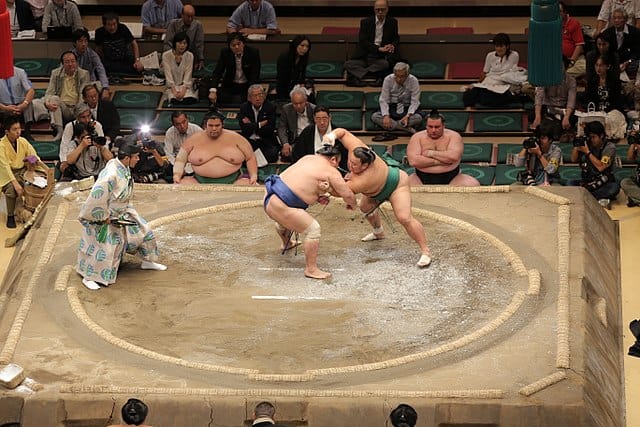
Sumo wrestling is a traditional Japanese sport that showcases the country’s rich cultural heritage. It involves two wrestlers, known as rikishi, who compete in a circular ring called a dohyo. The primary goal in a sumo match is to either push the opponent out of the ring or force them to touch the ground with any part of their body other than the soles of their feet. Matches are often brief but intense, filled with moments of strategic manoeuvres and displays of sheer strength.
More than just being a sport, sumo is also steeped in history and ritual. Before each match, rikishi perform ceremonial rituals, such as the purification of the ring with salt, a practice rooted in Shinto beliefs. These rituals are believed to ward off evil spirits and ensure a fair contest. The sport’s ceremonial aspects, combined with the dramatic clashes between rikishi, make sumo a unique and captivating experience for spectators.
The History of Sumo Wrestling
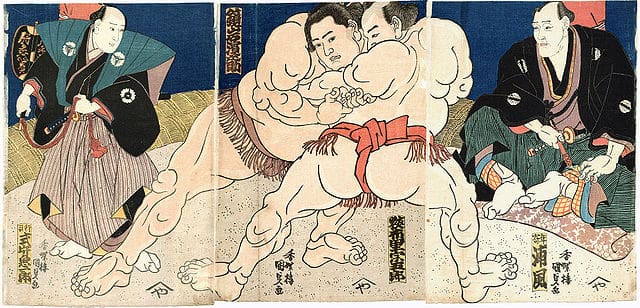
Ancient Origins
The origins of sumo wrestling can be traced back to ancient Japan, where it was initially performed as a religious ritual to entertain the deities and secure divine favour for a bountiful harvest. The earliest records of sumo wrestling date back to the 8th century, with mentions in historical texts like the Kojiki and Nihon Shoki, which chronicle the mythological and early historical events of Japan. In these early days, sumo was closely associated with agricultural festivals and Shinto shrines, where it was believed to appease the gods and ensure good fortune for the community.
Development into a Sport
Sumo began its transformation into a structured sport during the Edo period (1603-1868), a time of relative peace and cultural flourishing in Japan. It was during this era that the rules of sumo were formalised, and the sport began to take on the characteristics we recognise today. The establishment of professional sumo stables, or heya, provided a structured environment for training and discipline. Wrestlers began to be ranked according to their performance in tournaments, and these rankings determined their status and privileges within the sumo community.
The Edo period also saw the construction of dedicated sumo arenas, and matches became popular public spectacles, drawing large crowds. The formalisation of sumo wrestling turned it into a major form of entertainment, and it became an integral part of Japanese urban culture. The professionalisation of sumo meant that wrestlers could pursue the sport as a career, dedicating their lives to mastering its techniques and rituals.
Modern Sumo
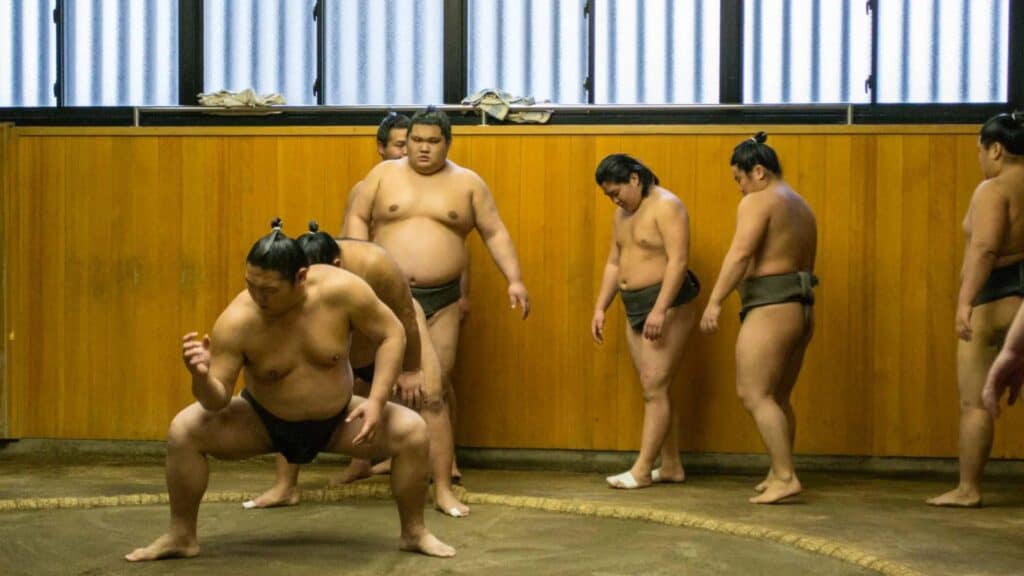
Today, sumo wrestling is a prominent professional sport in Japan, with a global following. Six major tournaments, known as honbasho, are held annually in various cities, including Tokyo, Osaka, Nagoya, and Fukuoka. Each tournament spans 15 days, and wrestlers compete to improve their rankings, which are updated based on their performance.
Sumo remains deeply intertwined with Japanese culture and tradition. Wrestlers, or rikishi, adhere to a strict lifestyle that includes rigorous training, a specific diet to maintain their weight, and living in sumo stables where they follow a hierarchical system. The highest-ranked wrestlers, known as yokozuna, are regarded with great respect and are expected to uphold the dignity and honour of the sport.
Sumo matches are preceded by elaborate rituals, including the dohyō-iri (ring-entering ceremony) and the shikiri-naoshi (pre-match ritual), where wrestlers engage in a psychological battle before the physical contest begins. These ceremonies, combined with the intense bouts, provide a unique insight into Japanese tradition and the enduring spirit of sumo wrestling.
For foreigners, attending a sumo tournament offers a fascinating glimpse into a world where sport and spirituality converge. The atmosphere in the arena is electric, with enthusiastic fans, the rhythmic clapping of hands during rituals, and the dramatic moments of each match creating an unforgettable experience.
Sumo Wrestling Rules, Techniques, and Key Terms
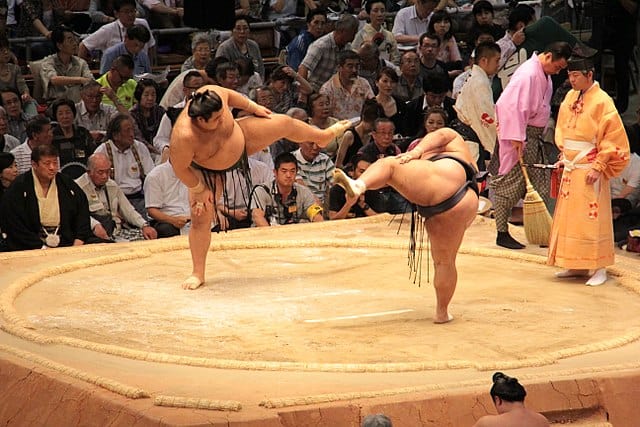
Basic Rules
- Winning: A match is won when a wrestler either forces their opponent out of the ring or makes any part of their opponent’s body, other than the soles of their feet, touch the ground. This can involve a variety of techniques, including pushing, throwing, or grappling. Victory is achieved through skill, strategy, and physical strength, often in a matter of seconds.
- Ring Size: The ring, known as the dohyo, is 4.55 metres in diameter. It is constructed from clay and covered with a thin layer of sand, which helps to highlight the point of contact when a wrestler is forced out or touches the ground. The boundaries of the ring are marked by rice-straw bales, which are buried slightly in the clay.
- Match Duration: Sumo matches are typically brief, lasting only a few seconds to a minute. However, they can occasionally extend longer if the wrestlers are evenly matched. Despite their short duration, matches are intense and require quick thinking and rapid execution of techniques.
Key Techniques
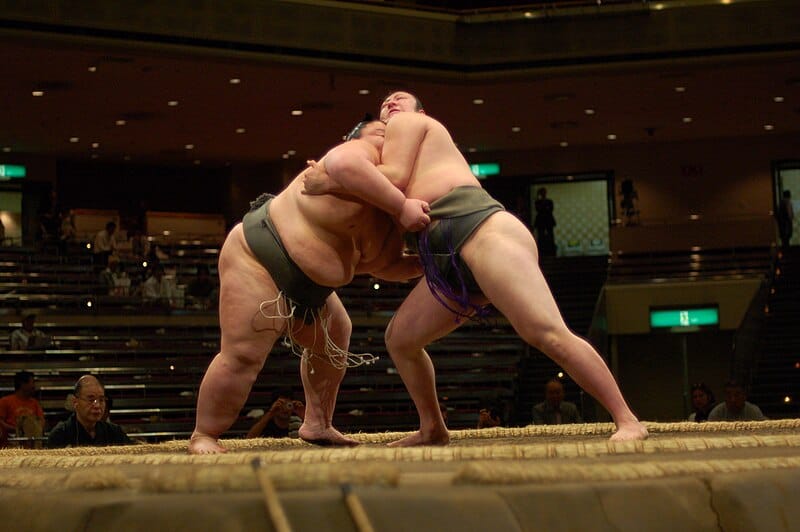
- Oshi-zumo (Pushing Techniques): This style involves pushing the opponent with hands and arms to drive them out of the ring or off balance. Techniques such as oshidashi (frontal push out) and tsukidashi (thrust out) are commonly used in this approach.
- Yotsu-zumo (Grappling Techniques): Grappling involves grabbing the opponent’s belt, known as the mawashi, and using leverage to control and manoeuvre them. Techniques like yorikiri (frontal force out) and uwatenage (overarm throw) are examples of grappling moves. This style requires strength and a good understanding of balance and positioning.
- Nage (Throwing Techniques): Throws are used to unbalance and topple the opponent. This can include techniques such as shitatehineri (twist down) and uwatenage (overarm throw). These moves often require precise timing and the ability to exploit the opponent’s momentum.
Key Terms in Sumo Wrestling
- Rikishi: This term refers to a sumo wrestler. Rikishi are ranked based on their performance in tournaments, with the highest ranks commanding significant respect and prestige.
- Yokozuna: The highest rank in sumo wrestling. Achieving the status of Yokozuna is a mark of exceptional skill and honour. Yokozuna are expected to maintain a high standard of conduct and performance, both in and out of the ring.
- Mawashi: The loincloth worn by wrestlers. It is an essential part of the sumo uniform, made from heavy cotton or silk and wrapped securely around the waist. The way a mawashi is tied can provide strategic advantages during matches.
- Tachiai: The initial charge at the start of a match. This is a critical moment where the wrestlers clash, trying to gain the upper hand right from the outset. The tachiai sets the tone for the rest of the match and requires both speed and power.
- Gyoji: The referee in a sumo match. Gyoji wear traditional attire and carry a wooden fan called a gunbai, which they use to indicate the winner. The role of the gyoji is not only to officiate the match but also to maintain the ceremonial aspects of the sport.
The Sumo Tournament Calendar
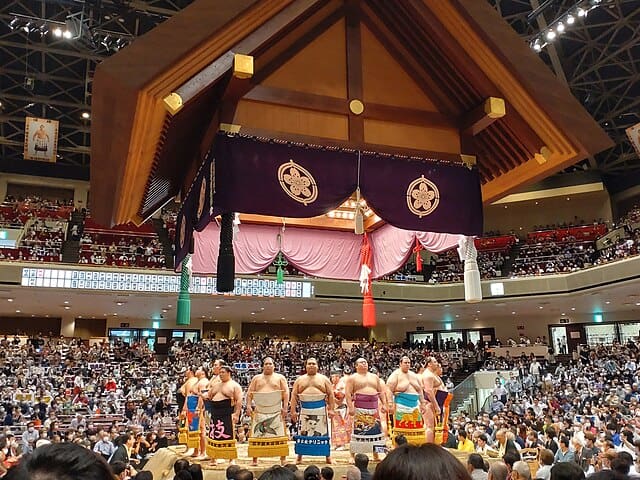
Sumo tournaments, known as honbasho, are major events in the Japanese sports calendar, held six times a year in various cities across the country. Each tournament lasts for 15 days, providing an opportunity for wrestlers to compete and improve their rankings. These tournaments are a vibrant spectacle and a highlight for many travellers visiting Japan. Here is a detailed overview of the sumo tournament calendar:
January: Tokyo (Hatsu Basho)
The first tournament of the year is held in Tokyo at the Ryogoku Kokugikan, the main sumo arena in the city. This tournament, known as the Hatsu Basho, kicks off the sumo season with much fanfare. The cold January weather contrasts with the heated competition inside the arena, making it a popular event for both locals and tourists.
March: Osaka (Haru Basho)
In March, the sumo wrestlers travel to Osaka for the Haru Basho. Held at the Osaka Prefectural Gymnasium, this tournament is known for its enthusiastic and lively crowds. The spring season adds a festive atmosphere to the matches, making it an exciting event to attend.
May: Tokyo (Natsu Basho)
Returning to Tokyo in May, the Natsu Basho is the third tournament of the year. Once again held at the Ryogoku Kokugikan, this tournament takes place during the warmer months, attracting large crowds eager to see their favourite rikishi in action. The energy and excitement in the arena are palpable as wrestlers compete to secure their positions.
July: Nagoya (Nagoya Basho)
The summer tournament is held in Nagoya at the Aichi Prefectural Gymnasium. Known as the Nagoya Basho, this event is characterised by the intense heat of the summer, both outside and inside the arena. Despite the scorching temperatures, the dedication and performance of the wrestlers draw significant attention.
September: Tokyo (Aki Basho)
Returning to Tokyo in September for the Aki Basho, the sumo wrestlers compete once more at the Ryogoku Kokugikan. The autumn season brings a different ambiance to the matches, with the cooler weather providing a refreshing change. This tournament is crucial for wrestlers looking to improve their rankings before the year-end.
November: Fukuoka (Kyushu Basho)
The final tournament of the year is held in Fukuoka at the Fukuoka Kokusai Center. Known as the Kyushu Basho, this event wraps up the sumo calendar with intense and highly competitive matches. The warmth and hospitality of Fukuoka’s residents make this a memorable tournament for both wrestlers and spectators.
How to Watch Sumo Wrestling
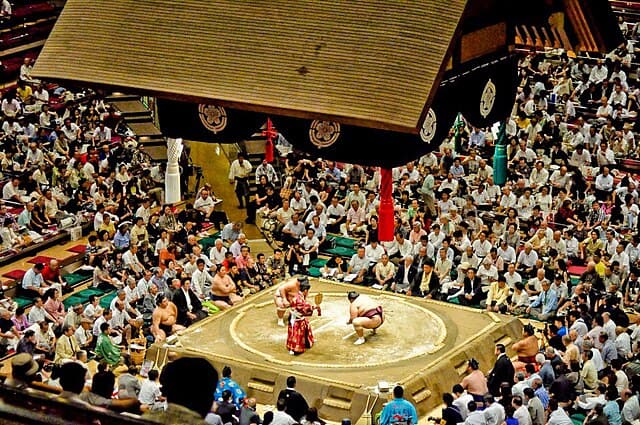
Buying Tickets
Online
Tickets for sumo tournaments can be purchased online through the official websites of the Japan Sumo Association or via travel agencies that specialise in Japanese cultural events. Websites like Buy Sumo Tickets provide English-language services and detailed instructions on how to secure your seats. It is advisable to buy tickets well in advance, especially for tournaments held in major cities like Tokyo and Osaka, as they tend to sell out quickly.
For a more personalised experience that goes beyond just sumo wrestling, consider taking advantage of Flip Japan Guide’s Travel Planning Service. Your first call is FREE!
Box Office
Tickets are also available at the venue box office on the days of the matches. However, it is important to note that popular days, particularly weekends and days featuring high-ranking wrestlers, can sell out rapidly. If you prefer to purchase tickets on the day of the event, it is wise to arrive early to avoid disappointment.
Types of Seats
Box Seats: These are traditional Japanese-style seating areas on the floor, known as masu-seki. Box seats typically accommodate four people and provide a close-to-the-action experience. Patrons sit on cushions and are expected to remove their shoes before entering the seating area. Box seats offer a unique and immersive way to experience the traditional atmosphere of sumo.
Arena Seats: For those who prefer Western-style seating, arena seats are available. These seats are individual chairs, offering a more familiar and comfortable seating arrangement. Arena seats are usually located further from the ring compared to box seats but still provide a good view of the matches.
Pricing
Ticket prices vary depending on the type of seat and the day of the tournament. Box seats are typically more expensive, with prices ranging from ¥10,000 to ¥40,000 per box, accommodating four people. Arena seats are more affordable, with prices ranging from ¥3,000 to ¥9,000 per seat. Premium seats closer to the ring are the most expensive and are often sold out quickly. Additionally, there are sometimes limited slots for special tickets that include perks such as souvenirs or meals.
For the latest and most accurate pricing, visit the Japan Sumo Association’s official website.
Tips for Attending a Sumo Tournament
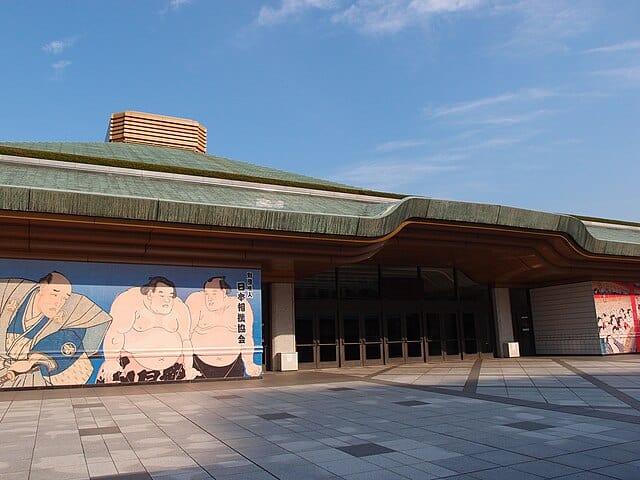
Arrive Early
Sumo tournaments begin in the morning, starting with matches between lower-ranked wrestlers. These early bouts are followed by matches featuring higher-ranked wrestlers in the afternoon, culminating in the top-ranked rikishi’s bouts later in the day. Arriving early allows you to experience the full range of matches and enjoy the build-up of excitement throughout the day.
Dress Respectfully
While there is no strict dress code for attending a sumo tournament, dressing smartly is encouraged as a sign of respect for the sport and its traditions. Opt for smart-casual attire, avoiding overly casual clothing such as shorts and flip-flops.
Observe Proper Etiquette
Observing proper etiquette is essential when attending a sumo tournament. Here are some key points to consider:
- Remain Quiet During Matches: Spectators should remain quiet during the matches to show respect for the wrestlers and the sport. Applause and cheers are appropriate at the end of a match, but avoid loud or disruptive behaviour.
- Refrain from Eating or Drinking: Eating or drinking in the seating area is discouraged to maintain the decorum of the event. There are designated areas within the venue for refreshments.
- Photography: Photography is generally allowed, but the use of flash or any equipment that might disturb others is prohibited. Always be considerate of other spectators when taking pictures.
- Respect Seating Arrangements: If you have box seats, remember to remove your shoes before entering the seating area and sit on the provided cushions. In arena seats, avoid placing bags or belongings on empty seats to ensure space for other spectators.
- Follow Venue Rules: Each venue may have specific rules and guidelines. Pay attention to announcements and follow the instructions of the staff to ensure a smooth and enjoyable experience for everyone.
Experiencing Sumo Beyond the Tournament
Sumo Stables
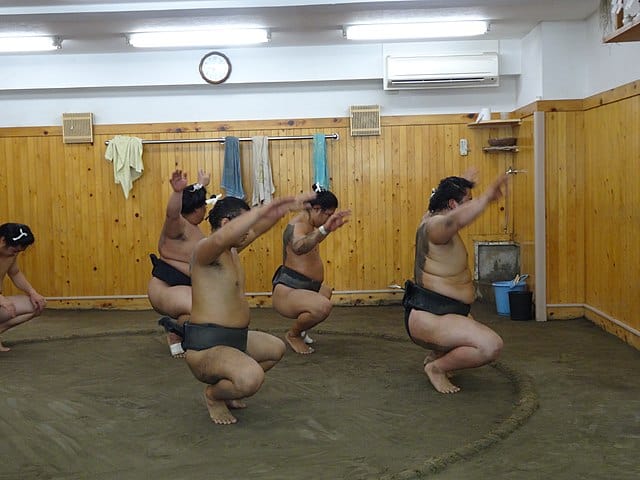
Visiting a sumo stable is one of the most immersive ways to experience the world of sumo wrestling beyond the tournament arena. These stables are where wrestlers live, train, and adhere to a strict regimen that shapes them into formidable athletes.
Observing a morning training session offers a rare glimpse into the dedication and discipline required in this ancient sport. During these sessions, you can watch wrestlers engage in rigorous exercises, practice matches, and the meticulous repetition of techniques.
To visit a sumo stable, it is essential to arrange a visit in advance, as many stables require reservations and have specific visiting hours. This is something Flip Japan Guide’s Travel Planning service can help you with! Just book a FREE call to start your consultation process.
Additionally, visitors are expected to follow strict etiquette rules, such as remaining silent during training and not taking flash photography. Some stables that are known for welcoming visitors include Arashio Beya and Kasugano Beya.
Sumo Museum
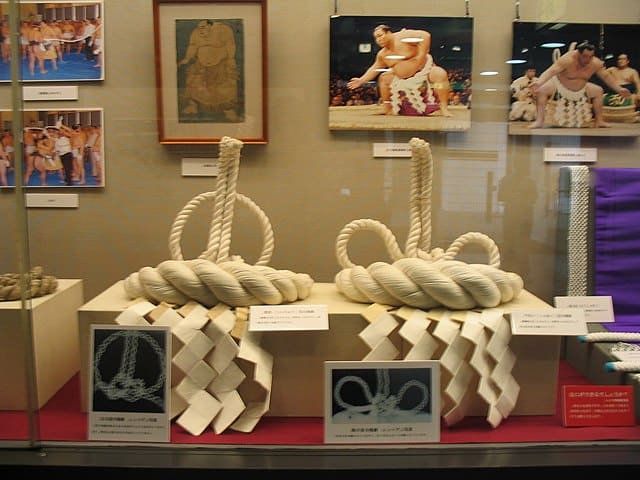
The Sumo Museum, located at the Ryogoku Kokugikan in Tokyo, is a treasure trove of sumo history and culture. Established in 1954, the museum houses a vast collection of sumo-related artefacts, including historical documents, ceremonial clothing, woodblock prints, and memorabilia from famous rikishi. Visitors can learn about the evolution of sumo, its cultural significance, and the lives of legendary wrestlers.
Exhibits change periodically, ensuring that there is always something new to discover. The museum also provides educational materials and displays in multiple languages, making it accessible to international visitors. Admission to the Sumo Museum is free, and it is open on days when sumo tournaments are not being held.
Dining with Sumo Wrestlers
One of the most unique and enjoyable ways to experience sumo culture is by dining at restaurants that serve chanko-nabe, the hearty stew that is a staple of sumo wrestlers’ diets. Chanko-nabe is a nutritious and calorie-rich dish made with various meats, fish, vegetables, and tofu, designed to help wrestlers gain and maintain their massive physiques.
Many of these restaurants are owned and operated by retired sumo wrestlers, offering patrons an opportunity to meet and dine with former rikishi. These establishments provide an intimate setting to learn more about the lifestyle and stories of sumo wrestlers while enjoying delicious food.
Popular chanko-nabe restaurants include Chanko Tomoegata and Chanko Kawasaki in Tokyo, where the atmosphere is steeped in sumo tradition, and the walls are often adorned with photographs and memorabilia from the owner’s wrestling career.
Enjoying the Sumo Culture
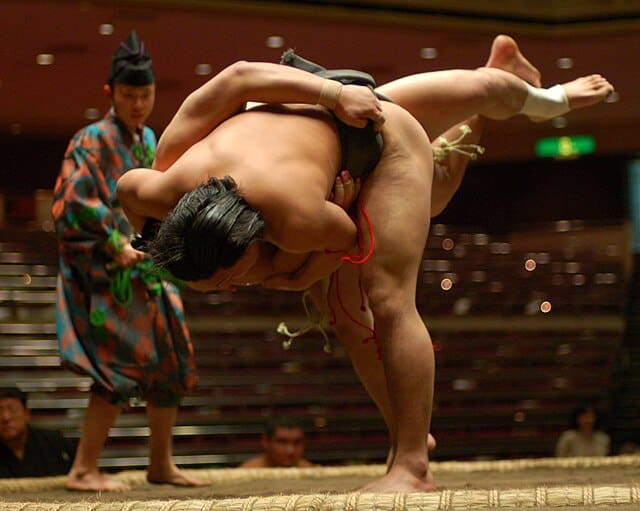
Sumo wrestling offers a unique and fascinating glimpse into Japanese culture. By understanding the tournament schedule, learning the basic rules and techniques, and following proper etiquette, you can fully enjoy the excitement of this ancient sport.
Beyond the matches, visiting sumo stables, exploring sumo museums, and dining on chanko-nabe with retired wrestlers add depth to your experience. Each activity provides a different view into the lives and traditions of sumo wrestlers.
Whether you are attending a match or exploring sumo culture outside the arena, this guide helps you make the most of your sumo experience.

